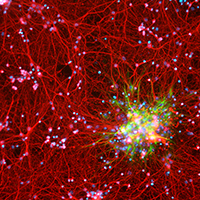Quantitative, structural and molecular changes in neuroglia of aging mammals: A review

Accepted: 27 May 2021
HTML: 11
All claims expressed in this article are solely those of the authors and do not necessarily represent those of their affiliated organizations, or those of the publisher, the editors and the reviewers. Any product that may be evaluated in this article or claim that may be made by its manufacturer is not guaranteed or endorsed by the publisher.
Authors
The neuroglia of the central and peripheral nervous systems undergo numerous changes during normal aging. Astrocytes become hypertrophic and accumulate intermediate filaments. Oligodendrocytes and Schwann cells undergo alterations that are often accompanied by degenerative changes to the myelin sheath. In microglia, proliferation in response to injury, motility of cell processes, ability to migrate to sites of neural injury, and phagocytic and autophagic capabilities are reduced. In sensory ganglia, the number and extent of gaps between perineuronal satellite cells – that leave the surfaces of sensory ganglion neurons directly exposed to basal lamina– increase significantly. The molecular profiles of neuroglia also change in old age, which, in view of the interactions between neurons and neuroglia, have negative consequences for important physiological processes in the nervous system. Since neuroglia actively participate in numerous nervous system processes, it is likely that not only neurons but also neuroglia will prove to be useful targets for interventions to prevent, reverse or slow the behavioral changes and cognitive decline that often accompany senescence.
How to Cite
PAGEPress has chosen to apply the Creative Commons Attribution NonCommercial 4.0 International License (CC BY-NC 4.0) to all manuscripts to be published.
Similar Articles
- S Desantis, G Ventriglia, D Zubani, A Corriero, Differential lectin binding patterns in the oviductal ampulla of the horse during oestrus , European Journal of Histochemistry: Vol. 49 No. 2 (2005)
- C. Loreto, C. Galanti, G. Musumeci, M. C. Rusu, R. Leonardi, Immunohistochemical analysis of matrix metalloproteinase-13 in human caries dentin , European Journal of Histochemistry: Vol. 58 No. 1 (2014)
- B Cuoghi, L Mola, Microglia of teleosts: facing a challenge in neurobiology , European Journal of Histochemistry: Vol. 51 No. 4 (2007)
- S Burattini, P Ferri, M Battistelli, R Curci, F Luchetti, E Falcieri, C2C12 murine myoblasts as a model of skeletal muscle development: morpho-functional characterization , European Journal of Histochemistry: Vol. 48 No. 3 (2004)
- C. Di Nisio, V.L. Zizzari, S. Zara, M. Falconi, G. Teti, G. Tetè, A. Nori, V. Zavaglia, A. Cataldi, RANK/RANKL/OPG signaling pathways in necrotic jaw bone from bisphosphonate-treated subjects , European Journal of Histochemistry: Vol. 59 No. 1 (2015)
- Flavia Carton, The contribution of immunohistochemistry to the development of hydrogels for skin repair and regeneration , European Journal of Histochemistry: Vol. 67 No. 1 (2023)
- A Germanà , MB Levanti, DF Monjil, E Ciriaco, Immunohistochemical detection of tyrosine kinase B (TrkB) in the enteric nervous system of the small intestine in pigeon (Columba livia) , European Journal of Histochemistry: Vol. 48 No. 4 (2004)
- K Tatsuyama, Y Maezawa, H Baba, Y Imamura, M Fukuda, Expression of various growth factors for cell proliferation and cytodifferentiation during fracture repair of bone , European Journal of Histochemistry: Vol. 44 No. 3 (2000)
- Anna Cleta Croce, Giovanni Bottiroli, Lipids: Evergreen autofluorescent biomarkers for the liver functional profiling , European Journal of Histochemistry: Vol. 61 No. 2 (2017)
- S Desantis, F Acone, A Corriero, Distribution of sialoglycoconjugates in the oviductal isthmus of the horse during anoestrus, oestrus and pregnancy: a lectin histochemistry study , European Journal of Histochemistry: Vol. 48 No. 4 (2004)
<< < 46 47 48 49 50 51 52 53 54 55 > >>
You may also start an advanced similarity search for this article.

 https://doi.org/10.4081/ejh.2021.3249
https://doi.org/10.4081/ejh.2021.3249










